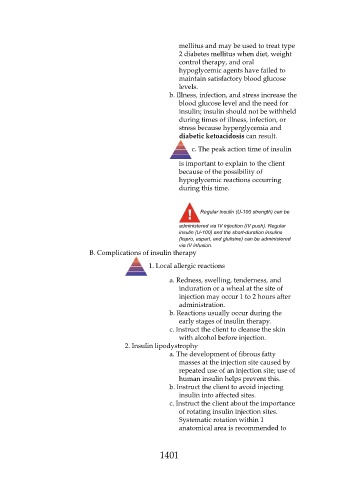Page 1401 - Saunders Comprehensive Review For NCLEX-RN
P. 1401
mellitus and may be used to treat type
2 diabetes mellitus when diet, weight
control therapy, and oral
hypoglycemic agents have failed to
maintain satisfactory blood glucose
levels.
b. Illness, infection, and stress increase the
blood glucose level and the need for
insulin; insulin should not be withheld
during times of illness, infection, or
stress because hyperglycemia and
diabetic ketoacidosis can result.
c. The peak action time of insulin
is important to explain to the client
because of the possibility of
hypoglycemic reactions occurring
during this time.
Regular insulin (U-100 strength) can be
administered via IV injection (IV push). Regular
insulin (U-100) and the short-duration insulins
(lispro, aspart, and glulisine) can be administered
via IV infusion.
B. Complications of insulin therapy
1. Local allergic reactions
a. Redness, swelling, tenderness, and
induration or a wheal at the site of
injection may occur 1 to 2 hours after
administration.
b. Reactions usually occur during the
early stages of insulin therapy.
c. Instruct the client to cleanse the skin
with alcohol before injection.
2. Insulin lipodystrophy
a. The development of fibrous fatty
masses at the injection site caused by
repeated use of an injection site; use of
human insulin helps prevent this.
b. Instruct the client to avoid injecting
insulin into affected sites.
c. Instruct the client about the importance
of rotating insulin injection sites.
Systematic rotation within 1
anatomical area is recommended to
1401

